This is the Audi Quattro De Paoli, it’s the first of the five that were made and despite its looks (and name) it actually contains far more Range Rover parts than Audi parts. This is because it’s a sillouette racer built on a Range Rover platform, with a composite body designed to look like a Quattro.
The vehicle was built by renowned Paris-Dakar and rally rapid competitor Franco de Paoli, an Italian gentleman racer, who used it to compete in the Dakar in 1986 and 1987, as well as the Rallye de l’Atlas in the same years.
Fast Facts – The Audi Quattro De Paoli
- The Audi Quattro De Paoli is undoubtably one of the more unusual vehicles built for the Paris-Dakar Rally. The Range Rover had proven its chops by winning the car class in the inaugural 1979 Paris-Dakar Rally, beating a Renault 4, a Fiat Campagnola, and a Toyota BJ.
- As the Dakar became more competitive the Range Rover became a mid-field runner, however Italian gentleman racer Franco de Paoli believed that a lightweight body on the rock-solid Range Rover underpinnings would be in with a chance of victory.
- De Paoli developed what is now known as the Audi Quattro De Paoli. It’s a Range Rover chassis and drivetrain, with modifications for racing. The original body which was largely made from steel was removed and replaced with an ultralight composite body made from fiberglass and Kevlar, with styling designed to look like an Audi Quattro.
- The Audi Quattro De Paoli is powered by the Rover 3.5 liter V8 with a manual transmission, it has uprated suspension, a 400 liter fuel tank, and it makes 230 hp. More recently it was given a restoration back to its original 1986 Paris-Dakar specification.
Who Is Franco de Paoli?
Franco de Paoli is revered as one of the most enduring of the early competitors in both the Paris-Dakar Rally and innumerable other rally raid events across the world. In total, Franco has competed in 20 runnings of the Paris-Dakar as a driver, and a further four as a journalist.
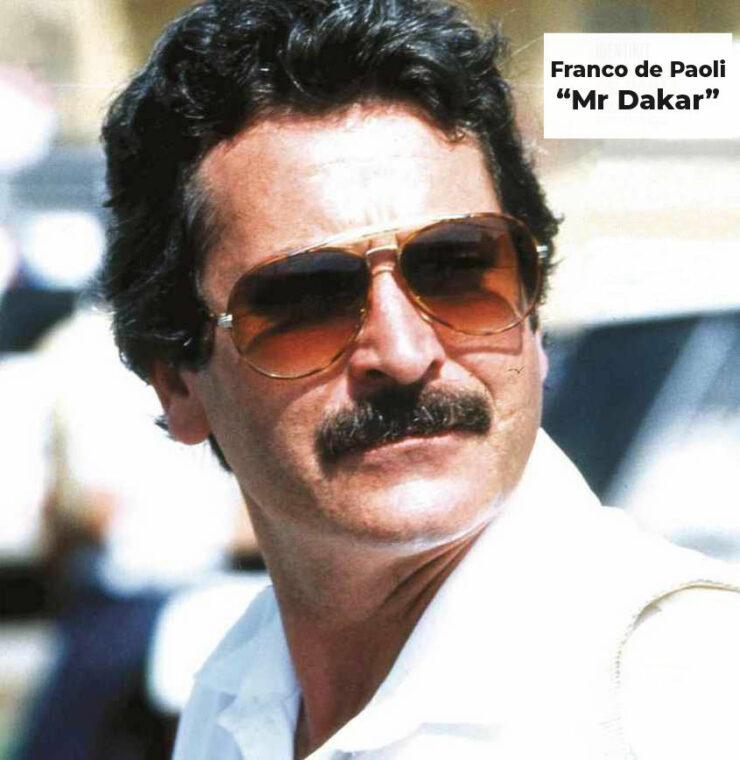
This is “Mr Dakar” Franco de Paoli in the 1980s looking every bit the gentleman Dakar racer. Image courtesy of Franco de Paoli.
For most people that would already be enough, too much even, but Franco was also competing in other events including 12 runnings of the Pharaoh’s Rally in Egypt, 8 Atlas Rallies in Morocco, 5 Rallies of Tunisia, the Qatar Rally, and a number of other events.
Franco and his team had a workshop just outside Milan in Italy where they build specialist racing vehicles for rally raids. Early on in his racing career he preferred to use the Range Rover chassis and drivetrain as a starting point, it was the vehicle that had won the inaugural Paris-Dakar Rally after all.
He drove highly-modified Range Rovers in the 1981 and 1981 Dakar, followed by a custom-made Rover 3500 built on a Range Rover chassis in 1983, 1984, and 1985. For 1986 Franco and his team built the vehicle you see shown in this article, an Audi Quattro silhouette body on a high-modified Range Rover chassis, which he then raced in the Dakar and the Rallye de l’Atlas 1986 and 1987.
He would later write a book about these experiences titled “80 Chilometri Dakar” or “80 Kilometers To Dakar” in English. Franco is now celebrated as a major veteran of the Dakar and he’s a popular guest speaker at related motorsport events.
The Origins Of The Paris-Dakar Rally
The brainchild of French racer Thierry Sabine, the Paris-Dakar Rally was born out of his own experience in the 1977 Abidjan-Nice Rally. Sabine became lost in the Tenere Desert in Libya and was struck by the beauty and vastness of the landscape. He envisioned an off-road race that would test the limits of human endurance and automotive engineering, while also showcasing the breathtaking beauty of Africa.
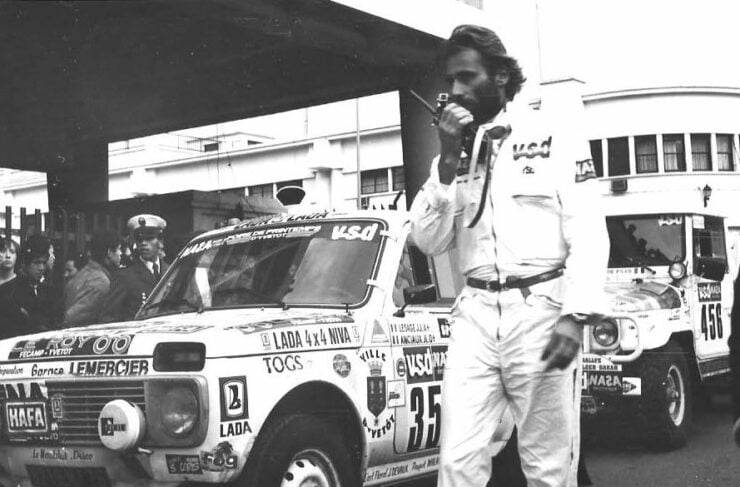
This is Thierry Sabine, a rally raid racer and the founder of the Paris-Dakar Rally. Tragically Sabine was killed in a helicopter crash while monitoring the Dakar event from the air in 1986. Image courtesy of Yelles M.C.A.
In 1978, Sabine brought his vision to life by organizing the first edition of the Paris-Dakar Rally, which began on December 26, 1978. Starting from the Place du Trocadéro in Paris, 182 vehicles (80 cars, 90 motorcycles, and 12 trucks) embarked on a 10,000 kilometer (6,214 mile) journey through France, Algeria, Niger, Mali, Upper Volta (now Burkina Faso), and Senegal, ultimately finishing in the Senegalese capital of Dakar on the west coast of Africa.
The inaugural Paris-Dakar Rally was won by Frenchman Cyril Neveu on a Yamaha XT500 motorcycle, while the first car category victory went to Alain Génestier, Joseph Terbiaut, and Jean Lemordant, driving a Range Rover. The first edition of the race was a resounding success, drawing widespread media attention and capturing the imagination of the public.
As the race gained popularity, the number of participants grew, and the event began to attract professional racers and factory teams. In 1980, the first factory-supported team to compete in the race was the French manufacturer Renault, with the Renault 20 Turbo 4×4 driven by brothers Claude and Bernard Marreau. They finished in first place, securing what would be the beginning of Renault’s position as a dominant force in the early years of the rally.
The 1982 edition of the race saw the introduction of the truck category, with a separate classification for heavy-duty vehicles. This move opened the door for a wider range of participants, including support vehicles and larger trucks specifically built for the rally. The first truck category winner was Georges Groine, driving a Mercedes-Benz Unimog.
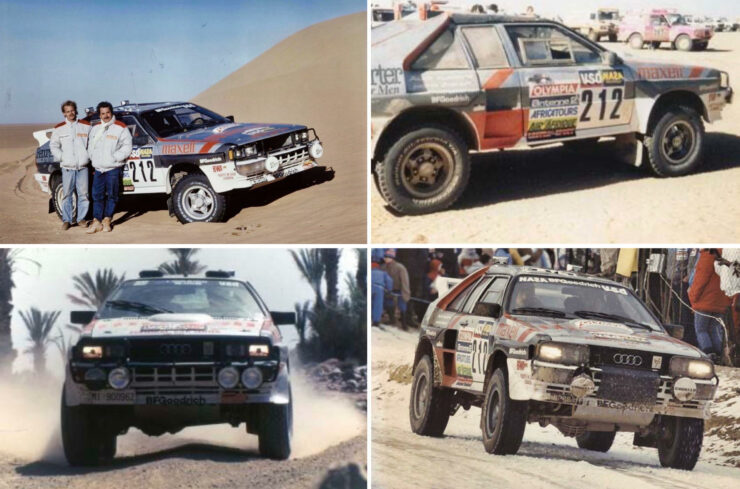
There were five variations of this Range Rover-based Audi made, the main car shown in this article is prototype number one.
One of the most iconic moments in the early years of the Paris-Dakar Rally occurred in 1983 when Jacky Ickx, a former Formula One driver, and Claude Brasseur claimed victory in a Porsche 953. This win marked the beginning of Porsche’s involvement in the rally, and the German manufacturer would go on to secure three consecutive victories from 1984 to 1986 with the legendary Porsche 959.
The Paris-Dakar Rally continued to grow in both size and reputation throughout the early 1980s, as new routes were introduced to explore different parts of Africa. In 1985 the race started in Versailles and traveled through the Sahara Desert, the Atlas Mountains, and Mauritania, eventually reaching Dakar. This edition of the race was notable for the dramatic victory of Ari Vatanen in a Peugeot 205.
The Audi Quattro De Paoli
Franco de Paoli built this highly-unusual rally raid vehicle back in 1985 to compete in the upcoming 1986 Dakar. Whereas his earlier creations had largely stock steel bodies that were strong but heavy, this one made use of lightweight fiberglass and Kevlar body panels moulded from the Audi Quattro – a vehicle that had been dominating Group B rally.
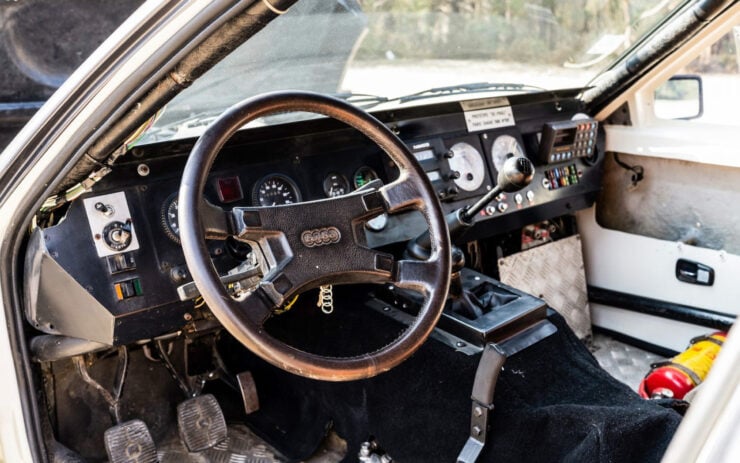
Looking at the large central tunnel running through the car belies its Range Rover underpinnings, if you looks closely you can see both the Range Rover gear lever and the lever for the dual-range transfer case.
Although the vehicle does use some Audi parts, it’s almost entirely bespoke and as such it can only really be called an Audi in the silhouette racer sense.
The Range Rover chassis had its rear cut down to reduce rear overhang, a common mod called “Bobtailling” in the Range Rover Classic community. The 3.5 liter alloy Rover V8 was modified to produce 230 bhp at 5,400 rpm, and it was mated to a 5-speed manual gearbox sending power back through a dual-range transfer case to all four wheels.
A new radiator was fitted to better cope with the desert heat, the disc brakes were uprated, and interestingly a self-leveling pneumatic suspension system was fitted with four airbags replacing the original steel coil springs. This system allowed ride height to be adjusted on the fly to suit conditions, and it was controlled by the co-driver from inside the car.
Fuel was provided by a prodigious 400 liter fuel cell, at an average speed of 200 km/h it contained enough gas for a range of 1,000 km/h between full ups. It’s believed that just five of these vehicles were made, all slightly different from one another, and the example you see here is prototype number one.
This rather eccentric Dakar racer is now due to cross the auction block with Aguttes on the 2nd of April with a price guide of 177,000 – 295,000 USD or €150,000 – 250,000. It comes with a French registration title and it would make an ideal competitor for the new Dakar Classic class. If you’d like to read more about it or register to bid you can visit the listing here.
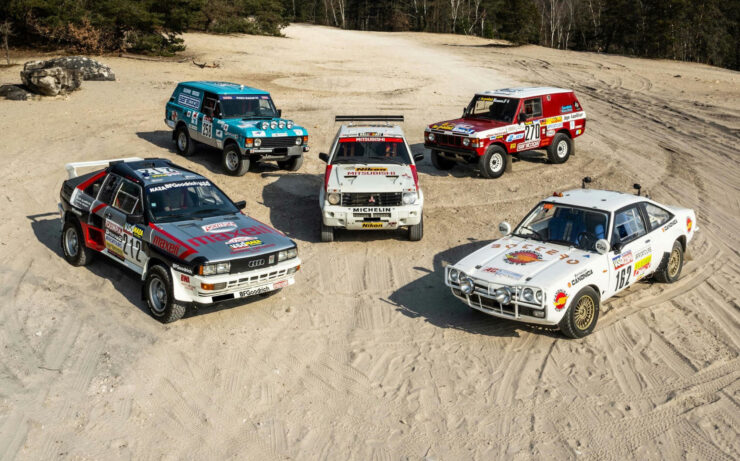
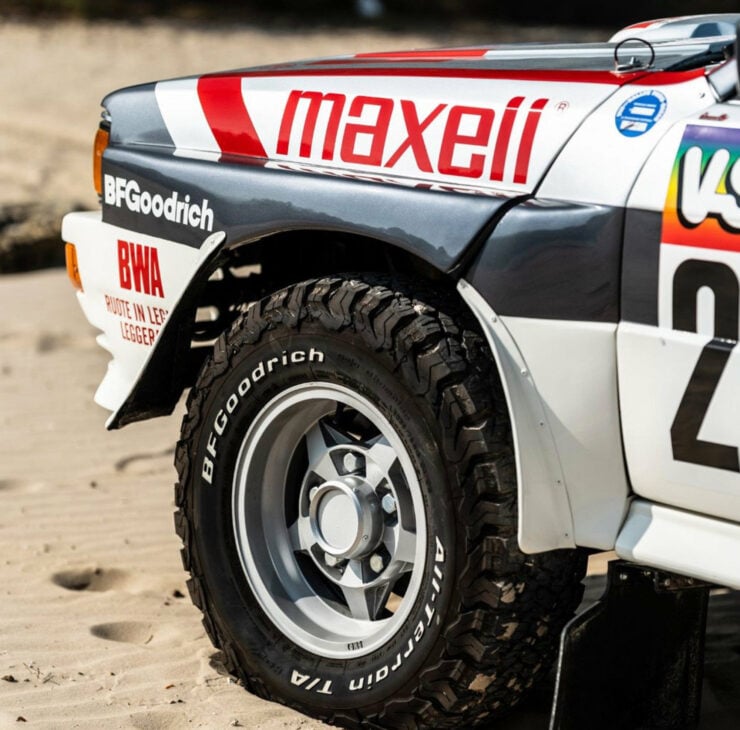
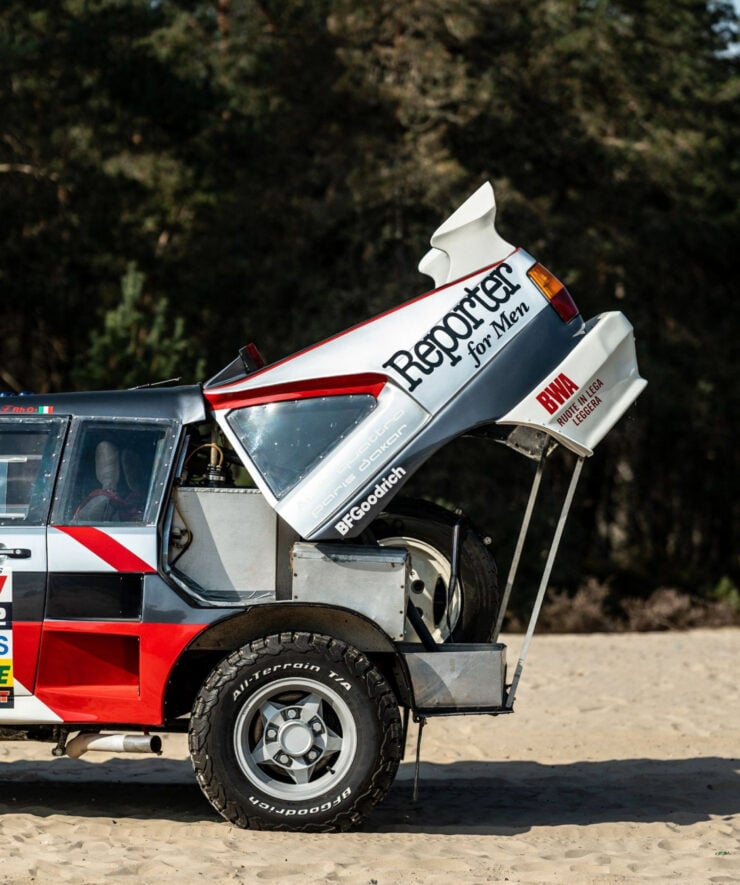
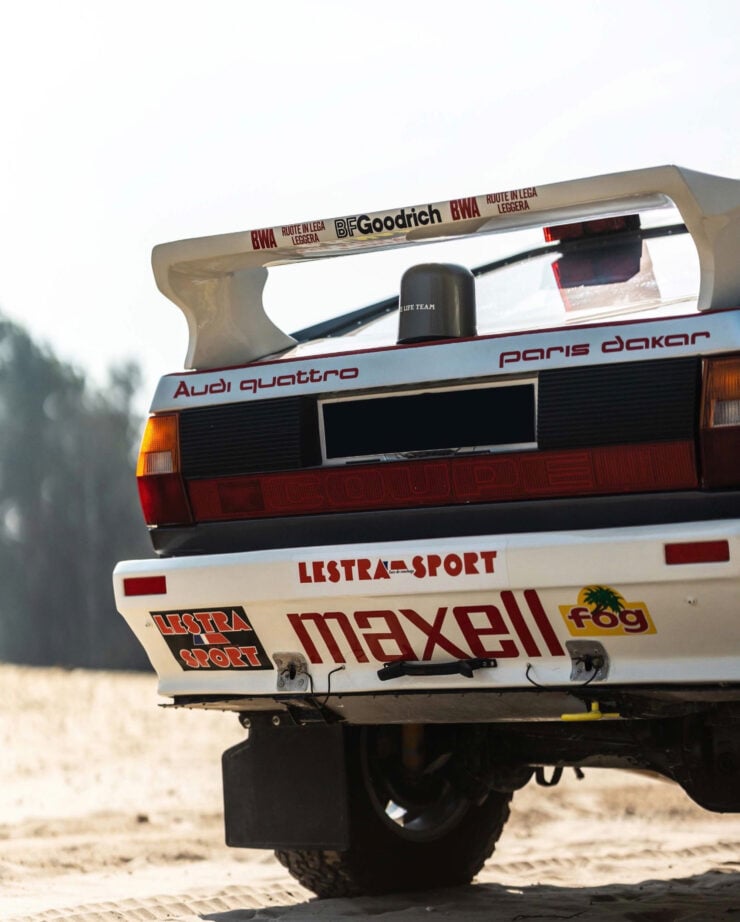
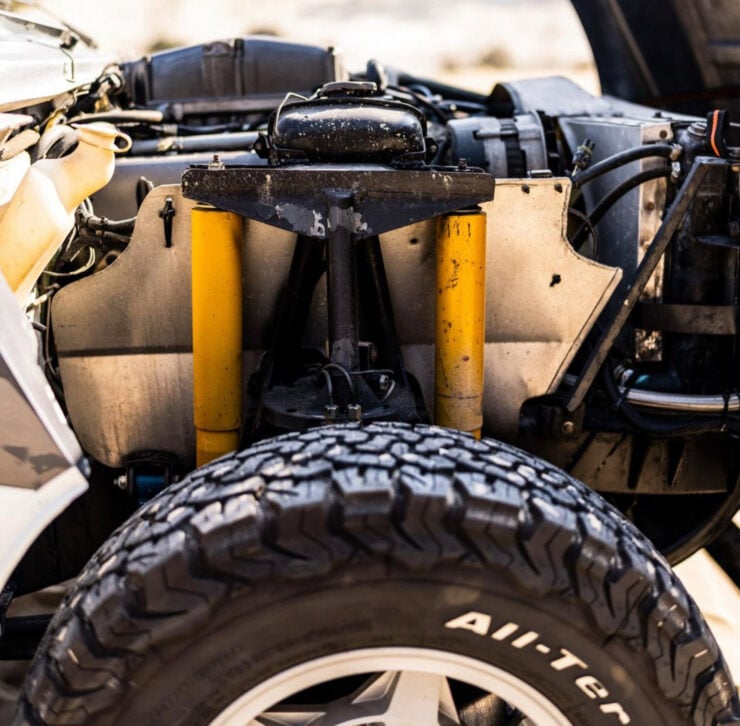
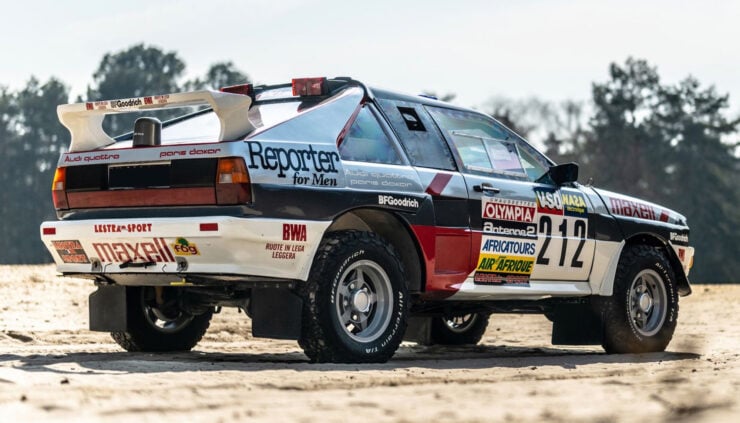
Images courtesy of Aguttes
The post The Rare “Audi Quattro De Paoli” – A Paris-Dakar Racer With A Range Rover Chassis appeared first on Silodrome.
from Silodrome https://silodrome.com/audi-quattro-de-paoli/
via gqrds